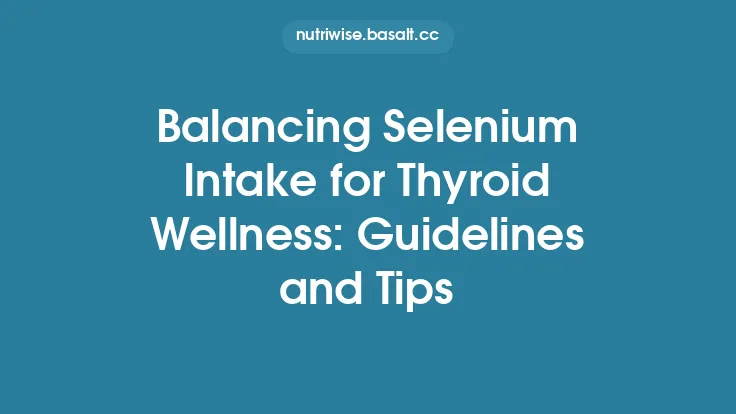Magnesium is a cornerstone mineral for anyone looking to build stronger, more resilient muscle tissue. While its reputation often centers on bone health and cardiovascular function, magnesium’s influence extends deep into the cellular machinery that governs muscle growth, repair, and durability. By understanding how magnesium works at a biochemical level and applying evidence‑based strategies to optimize its intake, athletes, fitness enthusiasts, and anyone engaged in regular physical activity can unlock measurable gains in muscle quality and long‑term resilience.
The Biochemical Foundations of Magnesium in Muscle Tissue
1. Energy Production and ATP Stabilization
Every contraction, repair process, and adaptation in muscle cells hinges on adenosine triphosphate (ATP). Magnesium binds to ATP, forming Mg‑ATP, the biologically active complex that fuels enzymatic reactions. Without sufficient magnesium, ATP cannot be efficiently utilized, leading to reduced energy availability for protein synthesis and cellular repair.
2. Protein Synthesis Pathways
Magnesium acts as a cofactor for ribosomal activity and for enzymes such as mRNA‑dependent protein kinase (PKR) and eukaryotic initiation factor 2 (eIF2). These enzymes regulate the translation of messenger RNA into muscle proteins, directly influencing hypertrophy and the maintenance of lean mass.
3. Mitochondrial Health and Oxidative Capacity
Mitochondria are the power plants of muscle fibers. Magnesium stabilizes the mitochondrial membrane potential and supports the activity of NADH dehydrogenase and ATP synthase, enhancing oxidative phosphorylation. A well‑functioning mitochondrial network improves endurance capacity and reduces the accumulation of reactive oxygen species (ROS) that can damage muscle fibers over time.
4. Calcium Regulation and Muscle Tone
While calcium triggers contraction, magnesium modulates calcium influx and efflux through the sarcoplasmic reticulum. By acting as a natural calcium antagonist, magnesium helps maintain optimal intracellular calcium concentrations, preventing excessive calcium loading that can lead to proteolysis and muscle breakdown.
5. Inflammation Modulation
Chronic low‑grade inflammation hampers muscle recovery and growth. Magnesium influences the NF‑κB signaling pathway, attenuating the production of pro‑inflammatory cytokines (e.g., IL‑6, TNF‑α). This anti‑inflammatory effect supports a more favorable environment for muscle remodeling.
Determining the Right Magnesium Dose for Muscle Resilience
| Population | Recommended Dietary Allowance (RDA) | Practical Upper Limit (UL) | Typical Supplemental Range |
|---|---|---|---|
| Adult men (19‑30) | 400 mg/day | 350 mg (supplemental) | 200‑300 mg/day |
| Adult women (19‑30) | 310 mg/day | 350 mg (supplemental) | 150‑250 mg/day |
| Athletes (high training volume) | 400‑420 mg/day (men) / 310‑350 mg/day (women) | 350 mg (supplemental) | 250‑400 mg/day (split doses) |
| Older adults (≥65) | 420 mg/day (men) / 320 mg/day (women) | 350 mg (supplemental) | 300‑450 mg/day |
*Note: The UL refers to magnesium obtained from supplements and fortified foods, not total dietary intake, because excess magnesium from food is generally well‑tolerated.*
Key considerations for dosing:
- Baseline Assessment – Use a combination of serum magnesium, red blood cell (RBC) magnesium, and, when available, ionized magnesium testing to gauge current status. Serum levels alone can be misleading, as they reflect only ~1 % of total body magnesium.
- Training Load – High‑intensity or volume training increases magnesium turnover through sweat loss and urinary excretion. Adjust intake upward proportionally (≈10‑20 % per additional hour of intense training).
- Body Composition – Lean individuals often have higher magnesium requirements per kilogram of lean mass compared with those with higher adiposity, due to greater metabolic activity of muscle tissue.
- Split Dosing – Dividing the total daily dose into 2‑3 smaller servings (e.g., morning, pre‑workout, evening) improves absorption and maintains steadier plasma magnesium concentrations throughout the day.
Choosing the Optimal Magnesium Form
| Form | Bioavailability* | Typical Dose (Mg elemental) | Best Use Cases |
|---|---|---|---|
| Magnesium glycinate | High (≈30‑40 % absorption) | 100‑200 mg | General muscle support, low GI tolerance |
| Magnesium citrate | Moderate‑high (≈20‑30 %) | 150‑300 mg | Pre‑workout, when rapid uptake is desired |
| Magnesium malate | Moderate (≈20‑25 %) | 150‑250 mg | Athletes seeking combined ATP support (malic acid) |
| Magnesium threonate | Emerging (crosses blood‑brain barrier) | 100‑150 mg | When neuromuscular coordination is a focus |
| Magnesium oxide | Low (≈4‑10 %) | 200‑400 mg | Primarily for laxative effect; not ideal for muscle optimization |
| Magnesium chloride | Moderate (≈15‑20 %) | 100‑200 mg | Topical applications (e.g., magnesium oil) for localized muscle comfort |
\*Bioavailability values are approximate and can vary with individual gut health and concurrent nutrient intake.
Practical recommendation: For most individuals aiming to enhance muscle resilience, magnesium glycinate or magnesium citrate strike the best balance between absorption efficiency and gastrointestinal comfort. Athletes who also want to support the Krebs cycle may favor magnesium malate due to the synergistic role of malic acid in energy production.
Timing Magnesium Around Training Sessions
| Timing | Rationale |
|---|---|
| Morning (upon waking) | Replenishes overnight losses and primes cellular ATP production for the day’s activities. |
| 30‑60 minutes pre‑workout | Elevates plasma magnesium, supporting calcium regulation during high‑intensity contractions and reducing the risk of calcium‑induced proteolysis. |
| Post‑exercise (within 2 hours) | Facilitates protein synthesis and mitochondrial repair when the muscle cells are most receptive to anabolic signaling. |
| Evening | Helps maintain magnesium levels during sleep, a period of heightened growth hormone secretion and tissue remodeling. |
Split dosing example: 150 mg glycinate in the morning, 150 mg citrate pre‑workout, and 100 mg glycinate before bed. This pattern sustains magnesium availability without overwhelming the gut at any single point.
Enhancing Magnesium Absorption: Dietary and Lifestyle Strategies
- Pair with Protein‑Rich Foods – Amino acids, especially glycine and arginine, form soluble complexes with magnesium, improving intestinal uptake.
- Limit Phytate‑Heavy Meals – Phytates (found in whole grains, legumes, and seeds) chelate magnesium, reducing its bioavailability. Soaking, sprouting, or fermenting these foods can degrade phytates and free up bound magnesium.
- Avoid High‑Oxalate Co‑consumption – Oxalates (present in spinach, beet greens, and rhubarb) bind magnesium similarly to calcium. Consuming magnesium supplements separate from high‑oxalate meals minimizes competition.
- Maintain Adequate Vitamin D Levels – Vitamin D upregulates intestinal calcium‑binding proteins that also facilitate magnesium transport. Ensuring serum 25‑OH vitamin D >30 ng/mL supports optimal magnesium absorption.
- Stay Hydrated – Adequate fluid intake promotes renal reabsorption of magnesium, preventing excessive urinary loss during sweat‑heavy sessions.
- Moderate Alcohol and Caffeine – Both increase renal magnesium excretion; limiting intake helps preserve magnesium stores.
Interactions with Other Micronutrients
| Nutrient | Interaction Type | Practical Guidance |
|---|---|---|
| Calcium | Competitive absorption; magnesium antagonizes calcium‑mediated muscle contraction | Aim for a dietary Ca:Mg ratio of roughly 2:1 (e.g., 800 mg Ca to 400 mg Mg). Separate high‑dose calcium and magnesium supplements by at least 2 hours. |
| Vitamin B6 (Pyridoxine) | Cofactor for magnesium‑dependent enzymes in amino acid metabolism | Include B6‑rich foods (e.g., poultry, bananas) or a modest B6 supplement (≈2 mg) to enhance magnesium utilization. |
| Zinc | High zinc doses (>30 mg) can impair magnesium absorption | If supplementing zinc for immune support, keep it ≤30 mg/day and stagger timing away from magnesium. |
| Potassium | Synergistic effect on cellular electrolyte balance | Ensure adequate potassium (≥3500 mg/day) through fruits, vegetables, and legumes to complement magnesium’s role in muscle tone. |
| Omega‑3 Fatty Acids | Anti‑inflammatory synergy | Combine magnesium with EPA/DHA to further dampen exercise‑induced inflammation, supporting muscle durability. |
Monitoring Progress and Adjusting Intake
- Biomarker Tracking
- Serum Magnesium: Target 0.75‑0.95 mmol/L.
- RBC Magnesium: Reflects intracellular stores; aim for 4.2‑5.0 mg/dL.
- Ionized Magnesium: Most physiologically active; 0.45‑0.60 mmol/L is optimal.
- Performance Metrics
- Strength Gains: Track 1‑RM (one‑rep max) improvements over 8‑12‑week cycles.
- Muscle Quality: Use ultrasound or bioimpedance to assess muscle thickness and lean mass changes.
- Recovery Indices: Monitor perceived muscle soreness (DOMS) and time to return to baseline performance.
- Adjustment Protocol
- If biomarkers are low but performance is stable: Increase supplemental dose by 50 mg and reassess after 4 weeks.
- If gastrointestinal upset occurs: Switch to a more gentle form (e.g., glycinate) or split the dose further.
- If serum levels exceed the upper normal range: Reduce total daily intake by 10‑20 % and evaluate dietary sources.
Special Populations and Considerations
| Group | Unique Needs | Tailored Recommendations |
|---|---|---|
| Endurance athletes | Higher sweat losses, prolonged oxidative stress | Emphasize magnesium malate + antioxidant co‑supplementation (vitamin C/E). |
| Strength‑focused lifters | Greater intracellular magnesium turnover due to high‑intensity bursts | Prioritize glycinate for steady release; consider pre‑workout citrate for acute demand. |
| Older adults | Age‑related decline in intestinal absorption | Use chelated forms (glycinate, threonate) and ensure vitamin D sufficiency. |
| Women with menstrual-related magnesium fluctuations | Hormonal cycles can affect magnesium status | Cycle‑specific dosing: higher intake during luteal phase (up to 20 % more). |
| Individuals on diuretics or PPIs | Medication‑induced magnesium loss | Add a modest maintenance dose (150‑200 mg) and monitor renal function. |
Common Pitfalls and How to Avoid Them
- Relying Solely on Serum Magnesium: Because serum levels represent a tiny fraction of total body magnesium, normal values can mask intracellular deficiencies. Pair serum testing with RBC or ionized measurements.
- Over‑Supplementing with Oxide: Magnesium oxide’s low bioavailability can lead to gastrointestinal distress without delivering meaningful muscular benefits.
- Neglecting Timing: Taking a large dose only once per day may cause a spike followed by a trough, leaving muscles under‑supported during critical training windows.
- Ignoring Food‑Drug Interactions: Certain antibiotics (e.g., tetracyclines) and bisphosphonates bind magnesium, reducing their efficacy. Space magnesium supplementation at least 2 hours apart from these medications.
- Assuming “More Is Better”: Excessive magnesium can cause diarrhea, electrolyte imbalance, and, in rare cases, cardiac arrhythmias. Stick within the UL for supplemental magnesium and adjust based on individual response.
Putting It All Together: A Sample 4‑Week Optimization Plan
| Week | Daily Magnesium (Mg elemental) | Form(s) | Timing | Additional Strategies |
|---|---|---|---|---|
| 1‑2 | 250 mg | 150 mg glycinate + 100 mg citrate | Morning (glycinate) + 30 min pre‑workout (citrate) | Add 300 mg vitamin B6 with breakfast; hydrate ≥2 L water/day |
| 3‑4 | 300 mg | 200 mg glycinate + 100 mg malate | Morning (glycinate) + post‑workout (malate) + bedtime (glycinate 50 mg) | Incorporate 1 g omega‑3 EPA/DHA daily; ensure 30 min of low‑phytate meals before supplement intake |
| Ongoing | Adjust based on biomarker feedback | Switch to threonate if neuromuscular coordination is a priority | Split as needed | Periodically re‑evaluate vitamin D status; aim for 40‑60 ng/mL 25‑OH D |
Key takeaways from the plan:
- Progressive loading allows the gut to adapt and minimizes laxative side effects.
- Form rotation (glycinate → citrate → malate) leverages distinct absorption kinetics and metabolic benefits.
- Synergistic nutrients (B6, omega‑3, vitamin D) amplify magnesium’s impact on muscle resilience.
Final Thoughts
Optimizing magnesium intake is more than hitting a daily number; it is a nuanced strategy that aligns mineral biology with training demands, dietary patterns, and individual physiology. By selecting high‑bioavailability forms, timing doses to coincide with periods of greatest muscular need, and supporting absorption through complementary nutrients and lifestyle habits, you can harness magnesium’s full potential to build stronger, more resilient muscle tissue. Regular monitoring—both biochemical and performance‑based—ensures that your approach remains precise, adaptable, and ultimately effective for long‑term muscular health.





